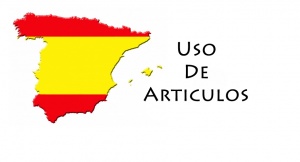Difference between revisions of "Language/Spanish/Grammar/Orientación-sobre-el-uso-de-Articulos"
m (Quick edit) |
|||
| (9 intermediate revisions by 4 users not shown) | |||
| Line 1: | Line 1: | ||
[[File:Uso-de-Articulos-Spanish.jpg|thumb]] | |||
¡Hola! 🎉 | |||
Aprender español puede ser bastante sencillo si te enfocas en la gramática. En esta lección, nos centraremos en la "Orientación sobre el uso de Artículos" en la gramática española. Además, si deseas profundizar en otros aspectos de la gramática española, te recomendamos que consultes nuestras páginas sobre [[Language/Spanish/Grammar/Questions|preguntas en español]], [[Language/Spanish/Grammar/Conditional-Mood|modo condicional]] y [[Language/Spanish/Grammar/Interrogation-signs|signos de interrogación]]. ¡Disfruta de la lección y sigue mejorando tus habilidades en español! 😊 | |||
==Conjugation== | ==Conjugation== | ||
Usually, we don't use the pronouns before the verbal conjugation. | Usually, we don't use the pronouns before the verbal conjugation. | ||
| Line 15: | Line 15: | ||
Let's look at the following: | Let's look at the following: | ||
===LA=== | ===LA=== | ||
"La" is used for words | "La" is used for feminine words which usually end in: | ||
*-a ( | *-a (perla, lógica, perra, ventana, puerta, amiga, pera) | ||
*-er (mujer | *-er (mujer) | ||
*-ra (primera, campera, tetera) | *-ra (primera, campera, tetera) | ||
===EL=== | ===EL=== | ||
"El" is Is used for words that end in: | "El" is Is used for masculine words that usually end in: | ||
*-e ( | *-e (Nene, ambiente, mueble) | ||
*-or (interior, superior | *-or (interior, superior) | ||
*-io ( | *-io (lío) | ||
*-o (sujeto, individuo, amigo, novio, marido) | *-o (sujeto, individuo, amigo, novio, marido) | ||
* the four points of the compass (Norte, sur, este, oeste) | |||
We never used an article before a verb. Most of the time we use one verb plus another verb. (quiero ir/ quiero tener/ quiero ver) (puedo ir/ puedo hablarte/ puedo querer). | |||
===Exceptions=== | |||
However, there are some exceptions. | |||
* Some words keep their form regardless of the gender to which they refer. Examples are: | |||
** el estudiante | |||
** la estudiante | |||
** el violinista | |||
** la violinista | |||
* Some words are written with any of the two articles. | |||
** el azúcar | |||
** la azúcar | |||
* Words like 'problema' end in '-a' but take the masculine article because they are masculine words. | |||
** el problema | |||
** el idioma | |||
*In some dialects, there are words like 'tribo' or 'tribu' which have masculine endings but are feminine and therefore take the feminine article. | |||
** la tribu | |||
However recently the word 'tribo' in some dialects has been converted to a masculine word. | |||
** el tribo | |||
| Line 36: | Line 55: | ||
Thank you, Hugo Dante. | Thank you, Hugo Dante. | ||
==Other Lessons== | |||
* [[Language/Spanish/Grammar/Adjectives|Adjectives]] | |||
* [[Language/Spanish/Grammar/The-Articles|The Articles]] | |||
* [[Language/Spanish/Grammar/Los-pronombres-personales|Los pronombres personales]] | |||
* [[Language/Spanish/Grammar/Use-of-verb-Haber|Use of verb Haber]] | |||
* [[Language/Spanish/Grammar/How-to-conjugate-in-spanish|How to conjugate in spanish]] | |||
* [[Language/Spanish/Grammar/Past-Participle|Past Participle]] | |||
* [[Language/Spanish/Grammar/Gender|Gender]] | |||
* [[Language/Spanish/Grammar/Questions|Questions]] | |||
* [[Language/Spanish/Grammar/¿Pluscuamperfecto?|¿Pluscuamperfecto?]] | |||
<span links></span> | |||
Latest revision as of 13:28, 25 March 2023
¡Hola! 🎉
Aprender español puede ser bastante sencillo si te enfocas en la gramática. En esta lección, nos centraremos en la "Orientación sobre el uso de Artículos" en la gramática española. Además, si deseas profundizar en otros aspectos de la gramática española, te recomendamos que consultes nuestras páginas sobre preguntas en español, modo condicional y signos de interrogación. ¡Disfruta de la lección y sigue mejorando tus habilidades en español! 😊
Conjugation[edit | edit source]
Usually, we don't use the pronouns before the verbal conjugation.
Examples:
- vamos a casa (We're going home)
- vamos a jugar (we are going to play).
Articles[edit | edit source]
I have discovered that for all people who want to learn Spanish, the most difficult is the use of the articles and how to locate them correctly.
Let's look at the following:
LA[edit | edit source]
"La" is used for feminine words which usually end in:
- -a (perla, lógica, perra, ventana, puerta, amiga, pera)
- -er (mujer)
- -ra (primera, campera, tetera)
EL[edit | edit source]
"El" is Is used for masculine words that usually end in:
- -e (Nene, ambiente, mueble)
- -or (interior, superior)
- -io (lío)
- -o (sujeto, individuo, amigo, novio, marido)
- the four points of the compass (Norte, sur, este, oeste)
We never used an article before a verb. Most of the time we use one verb plus another verb. (quiero ir/ quiero tener/ quiero ver) (puedo ir/ puedo hablarte/ puedo querer).
Exceptions[edit | edit source]
However, there are some exceptions.
- Some words keep their form regardless of the gender to which they refer. Examples are:
- el estudiante
- la estudiante
- el violinista
- la violinista
- Some words are written with any of the two articles.
- el azúcar
- la azúcar
- Words like 'problema' end in '-a' but take the masculine article because they are masculine words.
- el problema
- el idioma
- In some dialects, there are words like 'tribo' or 'tribu' which have masculine endings but are feminine and therefore take the feminine article.
- la tribu
However recently the word 'tribo' in some dialects has been converted to a masculine word.
- el tribo
I hope this contribution will serve as a simple guide.
Thank you, Hugo Dante.
Other Lessons[edit | edit source]
- Adjectives
- The Articles
- Los pronombres personales
- Use of verb Haber
- How to conjugate in spanish
- Past Participle
- Gender
- Questions
- ¿Pluscuamperfecto?
